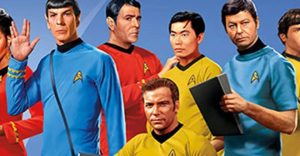It’s Too Late For Star Trek 4

Star Trek 4 may be going boldly at Paramount, but the sequel’s timing feels highly illogical – here’s why it’s too late for another Kelvin timeline Star Trek movie. When J.J. Abrams first stepped onto Star Trek‘s bridge in the mid-2000s, Gene Roddenberry’s sci-fi franchise was a dormant property. Its most recent movie and TV efforts – Star Trek: Nemesis and Enterprise, respectively – had both fallen short, and Star Trek was neither living long, nor prospering in the new millennium. Under Abrams, 2009’s Star Trek revitalized the Enterprise’s fortunes with a younger cast, a fresh timeline, and a shiny modern aesthetic. Star Trek Into Darkness (2013) and Star Trek Beyond (2016) then continued the new generation’s cinematic mission.
Sailing hasn’t been quite so smooth for Star Trek 4. At first, Paramount considered whether to continue J.J. Abrams’ Star Trek movie series at all, then the studio wanted to capitalize on Chris Hemsworth’s MCU fame by (somehow) bringing Kirk’s dad back. Kirk himself went AWOL amid reports Star Trek 4 was happening without Chris Pine, and Quentin Tarantino showed up for a little while too. Last the world heard, Star Trek 4 was still scheduled for November 2023. Matt Shakman (WandaVision) has replaced Noah Hawley as director (who in turn replaced S.J. Clarkson), and the sequel will reunite Abrams’ class of 2009.
In the latest chapter of Star Trek 4‘s saga, J.J. Abrams himself confirmed the project was moving forward. Talks with principle cast members are underway, and a script has been written by Josh Friedman and Cameron Squires ahead of a mooted late-2022 date for cameras to roll. Given Star Trek 4‘s tumultuous production, plenty could still go wrong. Assuming everything progresses as planned, however, isn’t it simply too late for Star Trek 4?
It’s Been Too Long Since Star Trek: Beyond

After Noah Hawley’s Star Trek 4 got (photon) torpedoed, Paramount was reportedly considering whether the beleaguered project was worth such hassle. According to Variety, the studio pushed on after determining audience affinity for the 2009 Enterprise crew led by Chris Pine remained strong. And Paramount’s market research is correct – despite the lengthy gap since Star Trek: Beyond, much love remains for the Kelvin cast, with casual and hardcore fans united behind the ensemble J.J. Abrams assembled. The biggest (some might say only) reason Star Trek 4 invokes any excitement is thanks to the chemistry between Pine, Quinto, Urban, Saldana, Pegg, and Cho (alongside Anton Yelchin, who passed away in 2016), and the stellar job they’ve done of steering the Enterprise across a trilogy of big screen adventures.
A beloved cast isn’t, however, reason alone to churn out more movies. Star Trek: Beyond left Paramount’s dock in 2016, and although Star Trek 4 is currently slated for November 2023, that date could prove rather too optimistic. If the main six cast members aren’t already tied down, scheduling may well trigger Star Trek 4‘s next headache. Karl Urban has supe-bashing duties in The Boys to think about, while Zoe Saldana is committed to 42 separate Avatar movies, meaning aligning everyone’s calendars before 2022 ends would be a maneuver worthy of Captain Kirk himself. Factor in COVID, reshoots, and those damn Tribbles, and Star Trek 4 could easily land closer to 2025.
Even without any delays whatsoever, the 7 years dividing Star Trek: Beyond and Star Trek 4 represent the longest gap between movies featuring the same crew, smashing the 4-year record held by Insurrection/Nemesis and Star Trek/Star Trek Into Darkness. Last time 7 years passed between Star Trek movies (from Nemesis to Abrams), the entire franchise was rebooted.
The problem with such a gap isn’t audiences falling out of love with the characters, since we know Pine, Quinto et al remain hugely popular. Star Trek 4‘s bigger obstacle is how drastically the world, the industry, and the Star Trek franchise has changed during the Kelvin crew’s shore leave. Star Trek Into Darkness was a commercial hit, but unpopular with die-hard fans. Star Trek: Beyond fared better among Trekkies, but flopped at the box office. 7 years down the line, the Star Trek fandom is even more divided, and traditional box office lays in tatters following a global pandemic. Although everyone may love the cast, it’s difficult to see how Star Trek 4 returns from the wilderness, pleases everyone, and makes a ton of money – especially after a troubled production playing out so publicly. If Star Trek 4 was going to happen, it should’ve happened straight after Star Trek: Beyond.
Star Trek’s Future Is Back On TV Again

Something else happened while the Enterprise was absent from movie theaters – Star Trek invaded TV screens again. A little over a year after Star Trek: Beyond fell from theatrical warp, Star Trek: Discovery began airing on CBS All Access (now Paramount+). Captain Michael Burnham has led her Discovery crew to small screen success, and is currently battling extra-galactic foes in the 32nd century as Star Trek: Discovery season 4 rumbles on. From that prosperity, Paramount has spawned an entire range of Star Trek TV content. Star Trek: Picard revisits the TNG era with a reborn Patrick Stewart, Star Trek: Lower Decks pokes fun at the franchise in animated form, and Star Trek: Prodigy makes overtures toward a younger audience. Rapidly bearing down is Star Trek: Strange New Worlds, starring Anson Mount’s Captain Pike and Ethan Peck’s Spock, and a little way behind are projects based upon Section 31 and Starfleet Academy.
By any measure, that’s enough Star Trek. If Paramount’s catalog of TV shows didn’t exist, a 7-year gap between Star Trek: Beyond and Star Trek 4 doesn’t look so bad, since audiences would be hungry for a return to Gene Roddenberry’s world. Instead, the rapid expansion of Star Trek content over the past 5 years means saturation point came and went sometime between Starfleet’s Klingon war and Jean-Luc becoming a robot. 2009’s Star Trek movie arrived to a fandom starved of swashbuckling sci-fi. Star Trek 4 no longer holds a monopoly on its own franchise, making another movie endeavor futile.
Kelvin Timeline Doesn’t Have Star Trek’s Best Stories

Not wanting his new Star Trek movie series shackled by 50 years of canon, J.J. Abrams experienced one of his trademark brainwaves – the Kelvin Timeline. Star Trek 2009 begins with a history-altering event that creates a parallel universe where the future is unwritten, meaning Khan can look like Benedict Cumberbatch, and Spock can use his Vulcan powers of seduction on Uhura, and that’s fine because this isn’t the same world William Shatner and Leonard Nimoy hail from.
Abrams’ Kelvin timeline was designed as a franchise reset button, separating Star Trek‘s future from its past. Paramount apparently had other ideas, and every Star Trek TV show since has returned to the warm embrace of familiar canon, effectively rendering the Kelvin timeline obsolete. Star Trek: Discovery shows the far future centuries after Janeway’s generation, Strange New Worlds acts as a direct prequel to The Original Series, and Star Trek: Picard has become a sequel to The Next Generation, answering the burning question of what came next for Jean Luc and his crew. Audiences are now fully invested in Star Trek‘s Prime continuity once more, and the Kelvin Timeline is something of a distant memory.
For Star Trek 4 to come along and say “forget all that” is a weird change of pace – especially with Star Trek: Strange New Worlds premiering in 2022. Do audiences want Ethan Peck and Zachary Quinto’s Spocks running side-by-side? Possibly not, and given the choice, most would choose canon over Kelvin, since Peck is the authentic young-Nimoy version of the Vulcan science officer, and Quinto is closer to a “what if…?” alternate at this point.
Had Paramount assimilated the Kelvin timeline as a setting for its Star Trek TV shows, Star Trek 4 wouldn’t feel so isolated. But rather than honoring the big reset J.J. Abrams engineered, the studio has focused squarely upon cultivating Star Trek‘s Prime universe, meaning that’s where the best stories currently reside. Returning to the cold, disused Kelvin timeline now has all the appeal of lukewarm Earl Grey.
How Star Trek 4 Can Connect To The TV Shows

Thanks to Star Trek: Discovery, Paramount’s TV shows needn’t sit separately from Star Trek 4. After Burnham’s crew arrived in the 32nd century, they learned about the Temporal Wars, and how Kelvin universe visitors continued crossing over long after Spock made the jump. That leaves the door firmly ajar for Chris Pine’s Enterprise crew to abandon its own timeline and (temporarily) join the Prime universe in Star Trek 4. With multiverses all the rage thanks to Spider-Man: No Way Home, that’s a direction Paramount would probably be interested in, and could alleviate many of the Kelvin franchise’s problems. A crossover uniting Pine’s Enterprise, Burnham’s Discovery, Picard’s La Sirena, and Pike’s early Enterprise against a single universe-hopping enemy would turn Star Trek 4 into a considerably more tantalizing prospect, and make that mammoth gap between movies irrelevant.
Alas, Paramount would likely prefer Star Trek 4 be a standalone film. Marvel and DC can get away with creating omni-franchise multiverses because the vast majority of viewers will already be acquainted with Tobey Maguire’s Spider-Man, Michael Keaton’s Batman, or Charlie Cox’s Daredevil. Star Trek movies typically cater for a more casual audience who don’t necessarily follow the TV output – especially since J.J. Abrams’ 2009 reboot. Consequently, connections between Star Trek 4 and the Paramount TV shows likely won’t extend beyond subtle Easter eggs and fleeting references.
About The Author


















